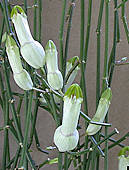 Photo: Sage Reynolds, Staten Island N.Y.
Ceropegia ampliata J.F. Drège 1830 (Bushman's Pipe)
Fleshy tuberous roots produce a green twining stem with only tiny vestigial lanceolate leaves that are short-lived. Fibrous aerial roots may form at stem nodes, especially where they touch the soil. The green and white tubular flowers smell of rotting carrion to attract flies and are followed by purple seed horns full of seeds packed with silken parachutes. Although seed horns are produced in pairs, only one usually develops fully.
Native to the Transvaal, KwaZulu-Natal, and Cape Province of South Africa and Madagascar.
|
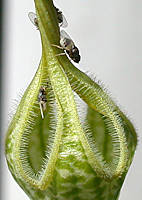 C. arabica C. arabicaPhoto: Sage Reynolds
Ceropegia arabica H. Huber 1957
A variable Ceropegia with thick twining stems. The white and green or white and puple mottled flower has its lobe tips fused into a distinctive sometimes twisted spire. The lobes have marginal hairs that trap inquisitive flies.
Native to Arabia.
This variable species has four recognised sub-species:
Ceropegia arabica var. arabica
Ceropegia arabica var. powysii
Ceropegia arabica var. abbreviata
Ceropegia arabica var. superba
|
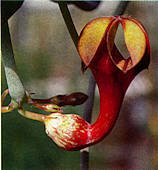
Ceropegia aristolochioides Decaisne 1838
Name: resembles flowers of the genus Aristolochia
Fleshy tuberous roots support a thick green stem that scrambles over the ground and other vegetation. The cordate leaves have a drip tip. The flowers in shades of red mottled with yellow or cream, have fused lobe tips to make a particularly striking 'lantern'. The lobe tips have a few hairs.
Native to a large range of tropical Africa including Burkina Faso, Cameroon, Chad, Ethiopia, Senegal, Somalia, Tanzania, Uganda, and Zaire. This species is considered edible and both root and leaves can be cooked for food. An infusion made from the stem and leaves is used to relieve itchy skin.
Photo: Jan Rimmek, Osnabrueck, Germany
|
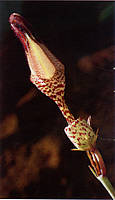
Ceropegia ballyana Bullock 1951
Named for: Peter René Oscar Bally who made the first description as C. helicoides.
This species has fibrous roots and twining green stems with obovate glossy green leaves. The inflorescence is white to yellow, speckled with maroon spots with the upper lobes of the 'lantern' slightly pubescent and fused at their tips.
Native to Kenya. In 1983 Kenya produced a postage stamp featuring flowers of Ceropegia ballyana.
Photo: Jan Rimmek, Osnabrueck, Germany
|
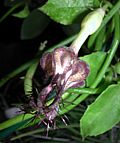 Photo: Renée Gaillard 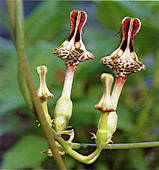 Photo:Jan Rimmek
Ceropegia denticulata K.M Schumann 1895
Thickened fleshy roots produce thick green twining stems with opposite pairs of ovate leaves whose margins bear tiny teeth. The purple to cream mottled with maroon flowers may have hairs over their surface with long filaments at the top of the "lantern". The flowers produce a fruity perfume.
Native to tropical Africa including Kenya, KwaZulu-Natal, Tanzania and Uganda.
|
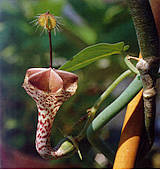
Ceropegia distincta N.E. Brown 1895 ssp. haygarthii (Schlechter) Huber 1957
A Ceropegia with fibrous roots, twining succulent stems and an unusual flower. The cream and purpled speckled flower has its five lobes fused to make a pentagonal structure, further ornamented with a narrow tube and a 5-winged 'lantern' with white hairs.
Native to Botswana, Namibia, South Africa and Zimbabwe.
Photo: Jan Rimmek
|
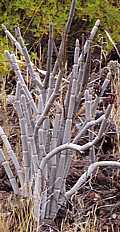
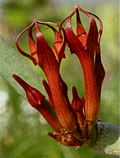
|
Ceropegia fusca Bolle 1861
Name: Latin fusca = very dark brown
This shrubby species consists of woody stems up to 4ft tall, branching near their base and bearing opposite pairs of lancolate deciduous leaves. Clusters of tubular, reddish-brown flowers are produced in the leaf axils. Their five narrow lobes join at the tip. Flowers are followed by pairs of long seed horns.
Native to the Canary Islands of Gran Canaria, and La Palma and Tenerife, favouring lava outcrops in full sun. Suitable for cultivation as an ornamental shrub in dry landscaping for tropical climates but requires heat and as much sun as possible to do well.
Upper left: Ceropegia fusca growing at Las Galletas, S. of Tenerife, Canary Islands.
Photo: Oscar L. Saavedra.
Lower left: Ceropegia fusca flower.
Photo: Jan Rimmek, Osnabrueck, Germany
|
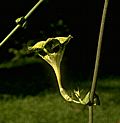 Photo: Sage Reynolds 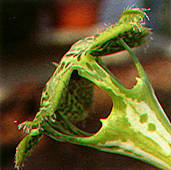 Photo: Jan Rimmek
Ceropegia sandersonii Decaisne ex Hooker f. 1869 (Umbrella Flower, Sambreelblom)
Named for: John Sanderson (1820-1881) Scottish botanist and collector in South Africa.
A distinctive Ceropegia whose thick twining stems bear opposite pairs of cordate succulent leaves and large pale yellow funnel-shaped flowers mottled with green, whose five lobes are fused into a corrugated dome ver the top of the funnel and are fringed with white hairs. This structure forms a trap for pollinating flies.
Native to South Africa, Swaziland and Mozambique. This species has a Royal Horticultural Society Award of Garden Merit.
|
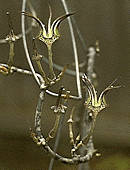
Ceropegia stapeliformis Haworth 1827 (Serpent / Snake Creeper, Slangkambro)
Name: stapeliiformis = resembles genus Stapelia
This Ceropegia has fibrous roots supporting a glaucous green trailing succulent stem with tiny vestigial leaves. The funnel-shaped flowers are greenish-white spotted with maroon and with white hairs on the margins of the five reflexed lobes which open freely. Flowers are followed by seed horns.
Native to South Africa and Swaziland, scrambling through scrub. It is often rooted in decomposing leaves under shrubs.
Photo: Sage Reynolds, Staten Island N.Y.
|
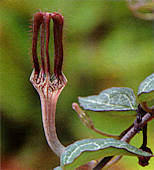 Photo: Jan Rimmek 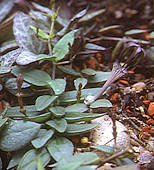 Photo: R.J.Hodgkiss
Ceropegia woodii Schlechter 1894 (Sweetheart Vine, Rosary Vine)
Syn. Ceropegia linearis ssp. woodii (Schlechter) H.Huber 1957
A Ceropegia with fibrous roots and forming small tubers at the stem nodes. The thin creeping succulent stems bear opposite pairs of dark-green cordate leaves, often veined or marbled in a paler colour. The lobes of the small pink to purple flowers are fused into a darker lantern at their apex with varying amounts of hairs. Their perfume is slightly disagreeable but mainly noticable to flies that become trapped in the lantern flowers.
Native to Natal. Commonly grown in hanging baskets and has a Royal Horticultural Society Award of Garden Merit. I find it grows better in a plant-saucer of gravel than when properly potted up in soil. This is definitely a Ceropegia that likes to explore the greenhouse staging and form tubers and roots under other pots.
|

 Families of Succulent Plants
Families of Succulent Plants 




 Families of Succulent Plants
Families of Succulent Plants 


